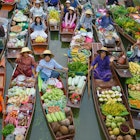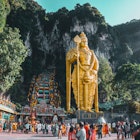

Dine outside in the warm tropical air on Jalan Alor Food Street in heart of Kuala Lumpur. Migel/Shutterstock
The best words to describe Malaysian cuisine are “kaleidoscope” and “fusion” — which makes writing a short introduction to eating and drinking in Malaysia a very difficult task. Few if no other countries are as multicultural as Malaysia — and that sheer, bedazzling ethnic diversity is reflected in the best Malaysian dishes. But what are the quintessential traditional foods of Malaysia that a first-timer should try?
Being exposed to centuries of seafaring trade from as far as the Middle East and India, China and Indonesia – not forgetting a lengthy colonial spell under the British from the end of the 18th century until Independence in 1957 – Malaysian food is not just a cornucopia of cuisines but a localized blend of ingredients that explodes into a unique campur (mixed) taste. The common elements? Fiery, tropical spices and the gift of incredibly flavorsome fruits.
Here are some of the basic recommendations for scratching the surface of the labyrinth of tastes called Malaysian food.

Unwrap the fat rice that binds a nation: nasi lemak
If there’s a common traditional food of Malaysia – something prepared and appreciated by most of the country’s ethnic groups – then that’s nasi lemak. Even Malaysia’s first astronaut, Dr Sheikh Muszaphar Shukor, brought it from Earth into space to feast on his motherland’s most cherished dish.
Literally meaning “fat rice,” it refers to the creaminess of the coconut milk infusion used to cook the grains. Served at its most basic with a douse of ikan bilis (fried local anchovies), sambal (chili and shrimp-infused paste) and peanuts, nasi lemak is a typical breakfast snack all over the country. Look out for the small pyramid-shaped banana leaf wraps on offer at most street stalls, and dig in with hands or a BYO reusable spoon. More filling portions come with a side of fried chicken, sliced cucumber and additional fried tofu or tempeh.
Where to try it: Most streetside eateries sell nasi lemak bundles as cold snacks. , a simple shop inside Kuala Lumpur’s SS15 market, makes an incredible, slow-cooked version with meat curries. For a classier cafe-type experience, try it at in the capital’s central Chinatown district.
Learn your rice: dig into nasi campur, nasi kandar and economy rice
Typical Malaysian meals are a base of rice sprinkled with all sorts of curries that you scoop from a tableful of metallic trays. From vegetables to chicken and beef, the selections are infinite. Each main ethnic group has its own: Malays have nasi campur (mixed rice) with creamier, tangier curries. Indian Muslims are masters of nasi kandar (meaning “pole rice” from the way the early Indian settlers shuttled the rice in buckets slung across their shoulders), eaten with more liquid curries fragrant with spices. The Chinese prepare "economy rice", which is lighter on the curry, has more stir-fried and vegetable options and is a very popular lunch choice. Try them all, remembering that you are charged by the spoonful – the more choices you take, the more you’ll pay.
Where to try it: Food haven Penang is also very famous for its nasi kandar, and in Little India is a great local choice to try with delicious chicken and beef curries. In Kuala Lumpur, locals swear by , a shop between the northern districts of Mont Kiara and Kota Damansara.

Try the different flavors of laksa
Contended by both Malaysia and Singapore as their own creation, laksa is a spicy noodle dish garnished with shredded mackerel, herbs, coconut milk, tamarind, and spices. It was invented by the Peranakan Chinese, but like all things Malaysian, it comes in several versions. Asam laksa has a strong umami flavour that doesn't sit well with everybody. In contrast, Thai laksa (locally known as laksa lemak or Siamese laksa) has a more aromatic and rich broth; and Sarawak laksa, typical of the namesake state in Malaysian Borneo, is a creamier version that combines chicken and prawn stock. Allegedly invented by the Sultan of Johor after a trip to Italy, laksa Johor is largely found in the southern peninsular state and uses spaghetti instead of vermicelli noodles layered in a thick gravy (kuah) made of fresh fish, dried shrimps, coconut milk and curry.
Where to try it: Penang is famous for its laksa. A legendary stall is arguably in the namesake market town. It risked closure during the COVID-19 pandemic, and now only opens on weekend mornings. On the southern side of the island, , in the main square of Balik Pulau town, has been dishing up excellent asam laksa for decades. While you are there, nearby , set inside the Nan Guang Kopitiam, is another famous spot worth trying.

Have a bite of amazing rendang
Born from the Minangkabau people of Sumatra, who had an early lineage with the Malay settlers of Peninsular Malaysia, rendang is one of the most beloved Malay dishes. This slow-cooked meat-based stew is braised in coconut milk, herbs and spices until it becomes tender and caramelized. It’s one quintessential meal for family reunions and celebrations such as Hari Raya Aidilfitri at the end of the Islamic fasting month.
Where to try it: If you can’t snare an invitation to a Malay wedding or family celebration, some of the best rendang to be had countrywide is on Peninsular Malaysia’s northeast coast and jungly interior. In Kota Bharu, makes a scrumptious version, along with other rice-based east coast Malay traditional dishes like coconut and fish curry-infused nasi dagang.
Explore the wild tastes of Borneo
Home to a staggering 59 different ethnic groups, the east Malaysian states of Sarawak and Sabah are set an ocean away on the island of Borneo and have quite a different type of cuisine that’s based on wild ingredients such as ferns and bushmeat that are not found in Peninsular Malaysia. One of the most versatile is midin, a local fern picked wild in the forest and served stir-fried. Cooking methods are different, too: Sarawak’s quintessential ayam pansuh, a delicious dish of fire-grilled chicken, is cooked by stuffing water, seasonings and tapioca leaves from the cassava plant inside bamboo stalks which must simmer next to a bonfire.
Where to try it: The good news is, you don’t have to visit a longhouse or trek deeply into Borneo’s interior to taste these unique local flavors, as most major cities have at least one restaurant specialized in jungle foods. In Kuching, chic offers a modern twist on traditional Sarawakian cuisine, while in Miri dishes up orang ulu food from the Kelabit Highlands. Try piquant wild vegetables and fermented, strong-scented meats that include the local kijang (a type of wild deer).
Vegetarians and vegans
Malaysia is extremely suited to vegetarians – and increasingly to vegans. Most cities have self-service vegetarian restaurants like , an economy rice-type spot in Penang’s Pulau Tikus. The Tamil heritage of most Malaysian Indians in Kuala Lumpur and along the West Coast of Peninsular Malaysia also means that you can find plenty of healthy south Indian vegetarian staples such as idli and various types of dosas.
There’s also an endless range of hip cafes that cater to vegans – and are pioneers in Kuala Lumpur’s tourist-central Petaling Street, while even smaller cities like Ipoh are catching up – try and .

Give it a try: durian
Love it or hate it, the spiky durian, dubbed the King of Fruits, is a fruit you can smell long before you see it. It’s a Malaysian icon and something that most locals grow addicted to. If it’s true that some visitors have described its smell as a mix of gas, raw sewage and unwashed socks, and the fruit is often banned at hotels or on planes, many others (including this writer) do get accustomed to the taste and rave about its creamy, delicious pulp which is one of Malaysia’s most prized exports.
Good places to try durian are the town of Bentong near the capital, popular for its sweet Musang King durian variety (also widely produced in the offbeat Lojing Highlands near Cameron Highlands), and the farms in Balik Pulau, Penang island’s southwestern green corner.
Explore related stories




 Destination Practicalities17 things you need to know before visiting Thailand
Destination Practicalities17 things you need to know before visiting ThailandSep 4, 2024 • 6 min read



 Destination PracticalitiesEverything you need to know before visiting Malaysia
Destination PracticalitiesEverything you need to know before visiting MalaysiaJul 25, 2024 • 7 min read
 Road TripsThe 8 best road trips in Malaysia for beaches, wildlife and more
Road TripsThe 8 best road trips in Malaysia for beaches, wildlife and moreJul 25, 2024 • 10 min read

